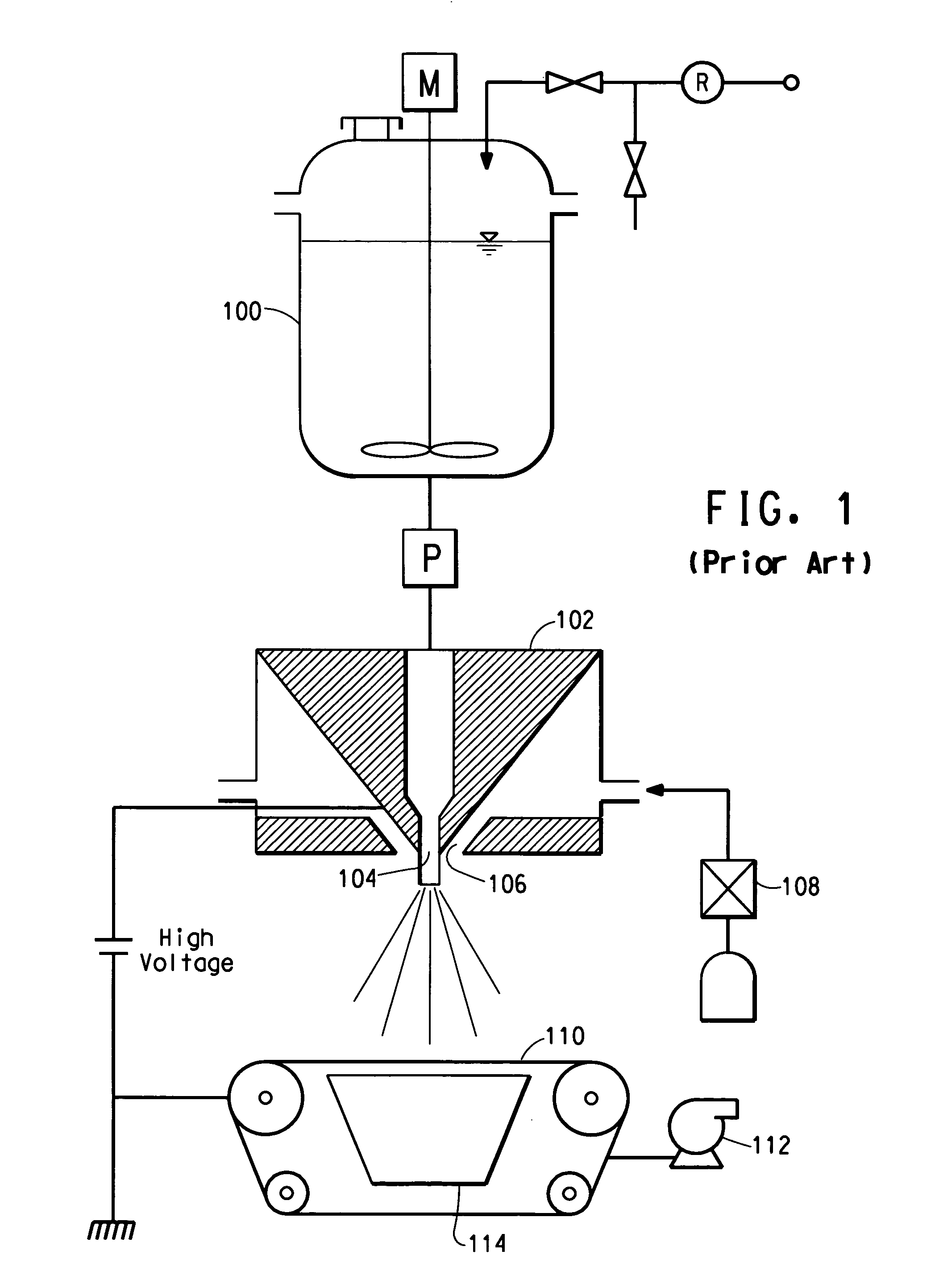Filtration media for filtering particulate material from gas streams
a technology of filtration media and gas stream, which is applied in the field of filtration media, can solve the problems of inability to meet the requirements of filtration media, inability to filter particulate material from gas streams, and inability to achieve stable filtration performance of hepa filters used in these applications,
- Summary
- Abstract
- Description
- Claims
- Application Information
AI Technical Summary
Benefits of technology
Problems solved by technology
Method used
Image
Examples
examples 1-4
[0037] Nanofiber layers were made by electroblowing a solution of DuPont Nylon 66-FE 3218 polymer having a density of 1.14 g / cc (available from E. I. du Pont de Nemours and Company, Wilmington, Del.) at 24 weight percent in formic acid at 99% purity (available from Kemira Oyj, Helsinki, Finland). The polymer and solvent were fed into a solution mix tank, the solution transferred into a reservoir and metered through a gear pump to an electroblowing spin pack having spinning nozzles, as described in PCT Patent Publication No. WO 03 / 080905. The spin pack was 0.75 meter wide and had 76 spinning nozzles. The pack was at room temperature with the pressure of the solution in the spinning nozzles at 10 bar. The spinneret was electrically insulated and applied with a voltage of 75 kV. Compressed air at a temperature of 44° C. was injected through air nozzles into the spin pack at a rate of 7.5 m3 / minute and a pressure of 660 mm Hg. The throughput of the solution was 2 cc / hole / min. The fibers...
example 2
[0040] The above described process was followed. The porous collection belt was moving at 11.3 m / minute. The vacuum chamber pulled a vacuum of 140 mm Hg beneath the porous belt.
[0041] A 60 m long sample was made by making two layers of continuous nanofibers having a nominal 10.0 g / m2 basis weight each, then one layer of nanofibers having a nominal basis weight of 5.0 g / m2, resulting in a total measured basis weight as set forth in Table 1. The fibers in the web formed had an average diameter of about 375 nm. The filtration efficiency was tested at various particle size challenges, and the results are given in Table 2. Pressure Drop (mm of water) was also measured and the results are given in Table 3.
example 3
[0042] The above described process was followed. The porous collection belt was moving at 11.3 m / minute. The vacuum chamber pulled a vacuum of 160 mm Hg beneath the porous belt.
[0043] A 60 m long sample was made by making two layers of continuous nanofibers having a nominal 10.0 g / m2 basis weight each, then two layers of nanofibers having a nominal basis weight of 5.0 g / m2 each, resulting in a total measured basis weight as set forth in Table 1. The fibers in the web formed had an average diameter of about 368 nm. The filtration efficiency was tested at various particle size challenges, and the results are given in Table 2. Pressure Drop (mm of water) was also measured and the results are given in Table 3.
PUM
| Property | Measurement | Unit |
|---|---|---|
| thickness | aaaaa | aaaaa |
| diameter | aaaaa | aaaaa |
| face velocity | aaaaa | aaaaa |
Abstract
Description
Claims
Application Information
 Login to View More
Login to View More - R&D
- Intellectual Property
- Life Sciences
- Materials
- Tech Scout
- Unparalleled Data Quality
- Higher Quality Content
- 60% Fewer Hallucinations
Browse by: Latest US Patents, China's latest patents, Technical Efficacy Thesaurus, Application Domain, Technology Topic, Popular Technical Reports.
© 2025 PatSnap. All rights reserved.Legal|Privacy policy|Modern Slavery Act Transparency Statement|Sitemap|About US| Contact US: help@patsnap.com

